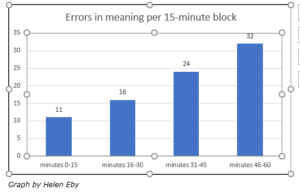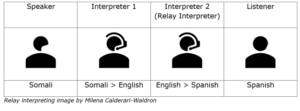For all events, whether in-person or remote
- Team interpreting: To preserve accuracy and prevent interpreter fatigue, a team of at least two interpreters is needed for each language pair (e.g., English<>Spanish, English<>Somali). A study conducted by Moser-Mercer et al. shows that errors in meaning committed by experienced conference interpreters while interpreting in the simultaneous mode begin to occur well before interpreters become aware of them. As shown in the table below, the error rate increases over time. This is why interpreters work in teams, switching with each other before their error rate increases.

- In advance of the event, speakers should supply the following to the interpreters:
- Agenda
- PowerPoint slides
- Videos (including links)
- Reference materials such as sections from poems or books that will be read aloud.
- Ask all speakers to speak at a pace of no more than 150 words per minute. This link has useful information on the topic.
- If more than two languages are spoken, it will be necessary to do relay interpreting, which has a greater delay than regular simultaneous interpreting. Therefore, the host should notify interpreters of all languages expected to be spoken before the event starts.
- Interpreters do not provide technical support. Accordingly, it is necessary to have a plan for troubleshooting and share it with the interpreters before the event starts:
- Who will be available to troubleshoot technical problems during the entire event?
- If the audience does not hear the interpreter, who will notify the interpreter?
Remote simultaneous interpreting (RSI)
- What RSI platform will be used?
- Does the RSI platform have enough channels for the number of language pairs needed?
- Have all speakers been asked to use a headset (headphones with incorporated microphone)? This video by David Violet explains why interpreters need higher quality sound than ordinary listeners.
- Have all speakers verified the reliability of their internet service? (High-speed, wide-bandwidth internet connection of at least 60 Mbps, with computers connected through an Ethernet cable. Internet providers provide speed tests.)
- Will there be a presession 30 minutes before the scheduled start time to onboard interpreters and speakers?
- Who will be assigned to read aloud from the chat box or Q&A so interpreters can render them in the other language?
Relay interpreting

Relay interpreting is the practice of interpreting from one language to another through a third language. It is necessary when no single interpreter commands the required language pair (e.g., Somali <> Spanish).Relay interpreting in Zoom
Before Zoom unveiled its relay enhancement, interpreters were not able to hear any other interpreter. Therefore, to be able to hear the relay interpreter they had to log in to the meeting as attendees with a second device. Now interpreters can hear the interpretation from other language pairs without using a second device. To see the Zoom enhancement for relay, interpreters and the host must have the Zoom Desktop client on their computers updated to version 5.9.6 or higher.
Instructions for hosts
The language interpretation feature is available only for scheduled meetings. See instructions under How to enable or disable language interpretation and How to add language interpreters to meetings or webinars.
Language interpretation can only be used in the main room, not in breakout rooms.
Instructions for participants
Participants cannot hear interpreters in the main-audio channel. All participants should select a language channel. See instructions under How to listen to language interpretation.
Instructions for interpreters
The language interpretation feature is available from the Zoom Desktop client, which is obtained by setting up a Zoom account. Therefore, interpreters should set up a personal Zoom account updated to version 5.9.6 or higher.
In any event hosted on Zoom, participants speak into the main-audio channel. The interpreters, on the other hand, speak only into their language channels (English or their other language).
When there is more than one language pair (e.g., English <> Spanish, English <> Somali), a participant could speak in the main-audio channel in a language the interpreter does not understand. In this case, relay interpreting must be used to allow all other participants to hear the audio in their preferred language. By default, interpreters listen to the main-audio channel, but with the relay enhancement they can choose whether to listen in the main-audio channel or another language channel.
Using the taskbar on the interpreter’s console, click on the speaking-to channel and choose their non-English language. The default listening-in channel will be the main-audio channel. To perform relay interpretation, interpreters must follow these steps:
- Using the taskbar on the interpreter’s console, click on the speaking-to channel and choose their non-English language. The default listening-in channel will be the main-audio channel.
- Click on the listening-in channel and choose the English channel to hear the interpretation into English. Then the relay interpreter will interpret from English into their other language. Remember to mute original audio.
Reference materials
- Average Speaking Rate and Words per Minute, by Virtual Speech
- How to listen to Language Interpretation, web page by Zoom
- Interpreters need higher quality sound than ordinary listeners, YouTube video by David Violet
- Moser-Mercer, B. Künzli, A., & Korac, M. (1998). Prolonged turns in interpreting: Effects on quality, physiological and psychological stress (Pilot study). Interpreting, 3(1), 47-64.
- Position Paper on Remote Interpreting, American Translators Association
- Position Paper on Team Interpreting, National Association of Judiciary Interpreters and Translators.
- Relay interpreting in Zoom, You Tube video by Katty Kauffmann
- Tips for speakers for virtual multilingual meetings, International Association of Conference Interpreters
By Helen Eby and Milena Calderari-Waldron
April 26, 2022
Remote-simultaneous-interpreting-checklist-20220426-1 PDF version

